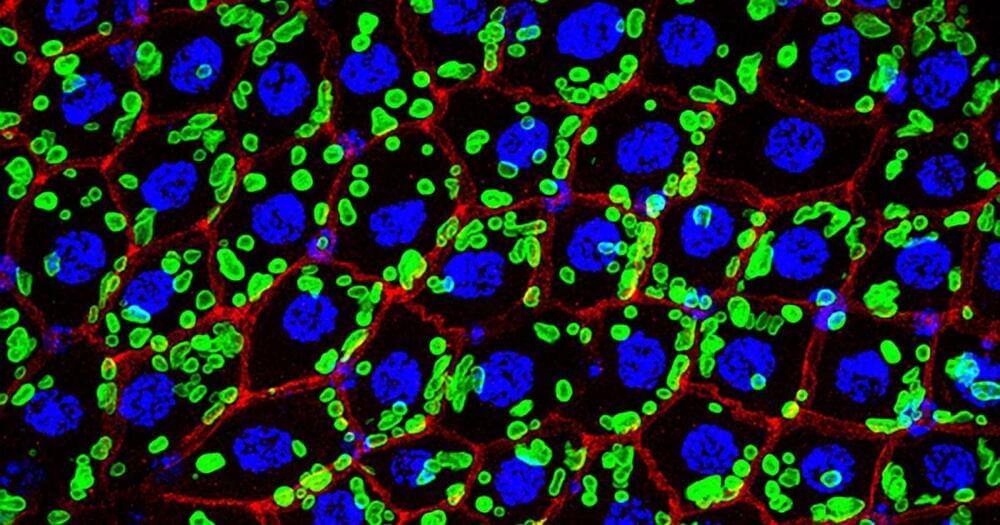SpaceX launched a batch of 56 Starlink satellites into orbit early Sunday from the Cape Canaveral Space Force Station in Florida and successfully landed a rocket in the sea.



This animation was created by using one day’s worth of data from Europe’s Meteosat Third Generation Imager-1 (MTG-I1) between March 18–19, 2023. Images of the full Earth disc are produced by MTG-I1 every 10 minutes. Credit: EUMETSAT/ESA
The Meteosat Third Generation Imager-1 (MTG-I1) was launched on an Ariane 5 rocket on Dec. 13, 2022, and is the first of a new generation of satellites set to revolutionize weather forecasting in Europe, according to the European Space Agency (ESA).

Rockefeller University researchers have discovered a new organelle inside the gut cells of the fruit fly — a surprise discovery, staring us in the face, in one of the most well-studied animals in all of science.
The new organelle stockpiles phosphate, an electrolyte essential to life. When faced with a shortage, it releases its reservoir in the form of phospholipids, which are a key component of the membrane structure of cells.
“This is one of the first studies to actually find phosphate storage in an animal cell,” Rebekka Wild told Nature’s Gemma Conroy. A structural biologist at French state research organization the Centre national de la recherche scientifique, Wild was not involved with the study.

A novel protocol for quantum computers could reproduce the complex dynamics of quantum materials.
RIKEN researchers have created a hybrid quantum-computational algorithm that can efficiently calculate atomic-level interactions in complex materials. This innovation enables the use of smaller quantum computers or conventional ones to study condensed-matter physics and quantum chemistry, paving the way for new discoveries in these fields.
A quantum-computational algorithm that could be used to efficiently and accurately calculate atomic-level interactions in complex materials has been developed by RIKEN researchers. It has the potential to bring an unprecedented level of understanding to condensed-matter physics and quantum chemistry—an application of quantum computers first proposed by the brilliant physicist Richard Feynman in 1981.

Year 2021 face_with_colon_three
Researchers at the University of Queensland in Australia claim to have invented the next generation of composite glass that they say could help make unbreakable smartphone screens in the future. While scientists have been working to create unbreakable glass for years, the technology has largely remained out of reach. Despite increased research in this area over the years, there’s no solution yet that is implementable on a commercial scale, which means despite various display protection technologies, glass remains pretty much as fragile and brittle as it has always been.

The revolution in artificial intelligence is at the center of a debate ranging from those who hope it will save humanity to those who predict doom. Google lies somewhere in the optimistic middle, introducing AI in steps so civilization can get used to it.
Demis Hassabis, CEO of DeepMind Technologies, has spent decades working on AI and views it as the most important invention humanity will ever make. Hassabis sold DeepMind to Google in 2014. Part of the reason for the sale was to gain access to Google’s immense computing power. Brute force computing can very loosely approximate the neural networks and talents of the brain.
“Things like memory, imagination, planning, reinforcement learning, these are all things that are known about how the brain does it, and we wanted to replicate some of that in our AI systems,” Hassabis said.


NEW YORK, May 12 (Reuters Breakingviews) — Trying to predict how a nascent and promising technology will affect society is hubris, but history suggests people are going to have some serious leisure time if the development of artificial intelligence continues apace. Whether that makes them happy, and how the spoils will be divided, are harder to predict.
Over the past 50 years, technology has tended to grow faster than the wider economy. From 2006 to 2016, the digital economy grew at an average annual rate of 5.6% according to the U.S. Bureau of Economic Analysis, or almost four times faster than the overall output. That sort of expansion appears to be oddly consistent. Revenue earned by technology companies in Fortune’s list of the 100 biggest U.S. firms has, adjusted for inflation, increased at a similar rate for five decades.
American employee productivity has increased about 2% annually for seven decades. While higher capital intensity and more skilled labor steadily contribute, what varies more is the ability to deploy technology successfully. Sectors able to automate tasks and reduce workers, such as manufacturing, will generally see higher productivity, while others, such as education, may have a harder time. This process also takes time. In 1987, the economist Robert Solow famously said computers were visible everywhere expect in the productivity statistics. A decade later, productivity shot up.

Orbital Assembly Corporation, a California-based company, has announced plans to build the world’s first-ever space hotel with artificial gravity. The hotel, called Voyager Station, is set to be completed by 2025 and will offer guests an out-of-this-world experience like never before.
The Voyager Station will be assembled in low Earth orbit and will be able to accommodate up to 280 guests and 112 crew members at a time. The hotel will feature restaurants, bars, a gym, and other recreational facilities, all of which will be designed to offer an experience similar to that of a luxury cruise ship.
One of the most unique features of the hotel is its artificial gravity system, which will use centrifugal force to simulate the feeling of gravity. This will allow guests to move around the hotel as they would on Earth, which will make their stay much more comfortable and enjoyable.

Cornell University researchers have developed a robot, called ReMotion, that occupies physical space on a remote user’s behalf, automatically mirroring the user’s movements in real time and conveying key body language that is lost in standard virtual environments.
“Pointing gestures, the perception of another’s gaze, intuitively knowing where someone’s attention is—in remote settings, we lose these nonverbal, implicit cues that are very important for carrying out design activities,” said Mose Sakashita, a doctoral student of information science.
Sakashita is the lead author of “ReMotion: Supporting Remote Collaboration in Open Space with Automatic Robotic Embodiment,” which he presented at the Association for Computing Machinery CHI Conference on Human Factors in Computing Systems in Hamburg, Germany. “With ReMotion, we show that we can enable rapid, dynamic interactions through the help of a mobile, automated robot.”